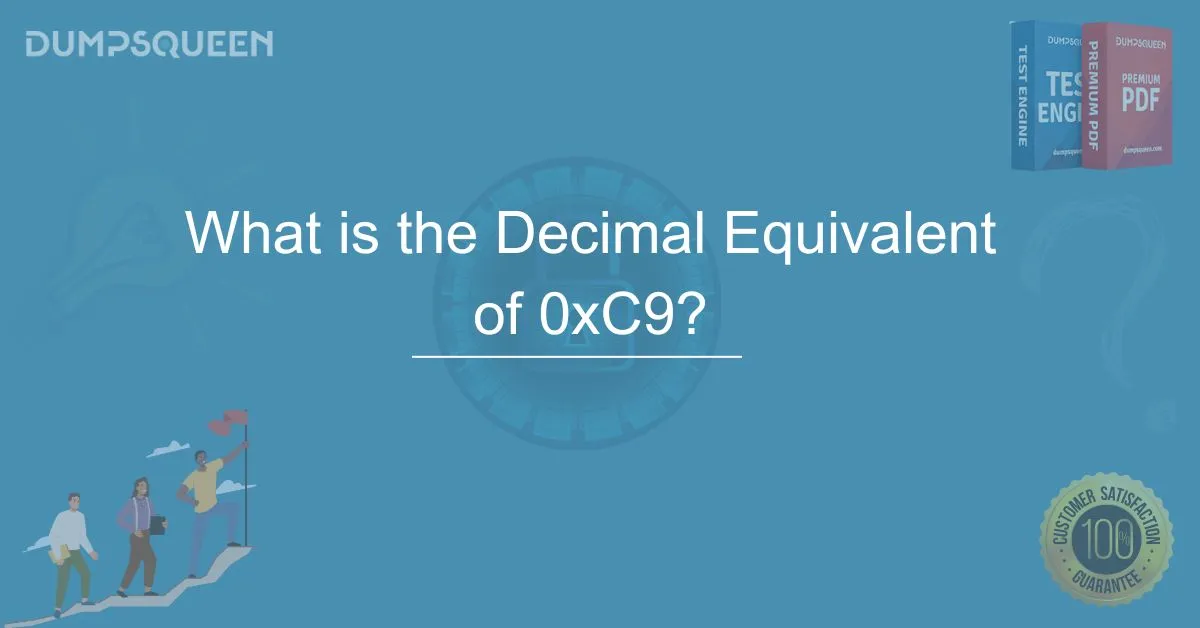Introduction
In the world of computing, numerical systems play a crucial role in various applications, ranging from programming to networking. Among these, the hexadecimal numbering system is widely used due to its efficiency in representing binary data. One common question asked in technical assessments and IT certifications is: What is the decimal equivalent of 0xC9?
To answer this, we must first understand how the hexadecimal numbering system works and how to convert it into the decimal system. This article, brought to you by DumpsQueen will provide an in-depth explanation of hexadecimal-to-decimal conversion, along with real-world applications and sample multiple-choice questions to test your knowledge.
Understanding the Hexadecimal Number System
The hexadecimal (base-16) number system is a positional numeral system that extends beyond the decimal system (base-10) by using sixteen distinct symbols. These symbols include:
-
0, 1, 2, 3, 4, 5, 6, 7, 8, 9 (same as decimal values)
-
A, B, C, D, E, F, where:
-
A = 10
-
B = 11
-
C = 12
-
D = 13
-
E = 14
-
F = 15
-
Since computers operate on binary (base-2), hexadecimal is often used as a shorthand notation for binary numbers. It provides a compact way to represent large binary values, making it essential in fields like computer science, networking, and digital electronics.
Conversion of 0xC9 to Decimal
To convert a hexadecimal number like 0xC9 into its decimal equivalent, we need to break it down based on its positional values.
Breaking Down the Hexadecimal Value
The hexadecimal number 0xC9 consists of two digits:
-
C (which is 12 in decimal)
-
9 (which remains 9 in decimal)
In a base-16 system, each position represents a power of 16. The rightmost digit represents 16^0, the next represents 16^1, and so on.
Applying the Positional Values
The conversion formula follows this structure:
Breaking it down further:
-
12 × 16 = 192
-
9 × 1 = 9
Adding these values together:
Thus, the decimal equivalent of 0xC9 is 201.
Importance of Hexadecimal in Computing
Hexadecimal numbers are widely used across various computing applications, making them a fundamental concept for IT professionals. Below are some common areas where hexadecimal notation plays a significant role:
Memory Addressing
Computers store data in memory locations, which are often represented using hexadecimal numbers. This is because hex allows for a more compact and human-readable representation of binary addresses.
Networking and MAC Addresses
Networking devices, such as routers and switches, use hexadecimal notation in MAC (Media Access Control) addresses. A MAC address, which uniquely identifies network devices, typically consists of six pairs of hexadecimal digits (e.g., 00:1A:2B:3C:4D:5E).
Web Design and Colors
Hexadecimal values are used in defining colors in web design. For example, the color red is represented as #FF0000, where FF corresponds to the highest intensity of red in hexadecimal notation.
Machine Code and Assembly Language
Low-level programming languages, such as Assembly, often use hexadecimal notation for representing machine instructions. This helps programmers write efficient code that interacts directly with hardware components.
Conclusion
Understanding hexadecimal-to-decimal conversions is a valuable skill for IT professionals, especially those involved in networking, programming, and cybersecurity. The hexadecimal number 0xC9 converts to 201 in decimal using a straightforward mathematical process. Mastering this conversion will allow you to interpret and manipulate data more effectively in various computing environments.
For more in-depth study materials, certification resources, and expert guidance on IT exams, visit DumpsQueen. We provide top-quality content to help you succeed in your IT certification journey.
Limited-Time Offer: Get an Exclusive Discount on Cisco 200-301 CCNA – Order Now!
Free Sample Questions
1. What is the decimal equivalent of 0xC9?
A) 193
B) 200
C) 201
D) 255
Answer: C) 201
2. Which hexadecimal number represents the decimal value 201?
A) 0xC8
B) 0xC9
C) 0xD0
D) 0xB9
Answer: B) 0xC9
3. What is the base of the hexadecimal numbering system?
A) 2
B) 8
C) 10
D) 16
Answer: D) 16



